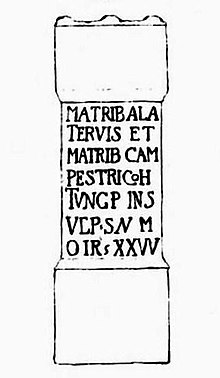Matrae Alaterviae
The Alaterviae are matrons that have been handed down from an dedicatory inscription from Cramond near Edinburgh in Scotland from around the 3rd century.
Discovery and Inscription
The stele-shaped votive stone made of sandstone was found around 1697 during the renovation of the “Cramond House” as a construction in the foundation. The stone and inscription was described by the Scottish antiquarian John Horsley when it was set up in the garden of the Scottish nobleman Sir John Inglis at the site. The antiquarian John Philip Wood last mentioned it in 1794, since then the stone has been lost. Both Horsley and Wood describe the poor state of preservation due to the effects of the weather.
"Matrib (us) Ala / tervis et / Matrib (us) Cam / pestrib (us) coh (ortis) I [I] / Tungr (orum) ins (aunt) / VERSCARM / […] leg (ionis) XX V ( aleriae) V (ictricis) "
"The matrons Alatervae (?) And the matrons Campestres established [by] the first (or second) cohort of the Tungerer under the leadership of ... Centurion of the XX Legion Valeria Victrix"
The stone was donated by a Germanic auxiliary unit of the Tungrians of Legio XX Valeria Victrix . The sequence VERSCARM in line 6 has been disrupted or described as illegible, indefinable (Horsley) and has therefore led to different readings. Among other things as the personal name of a Germanic centurion Ulpius Scram, the epithet being a presumed abbreviation to Old High German scerem = "shield". In recent (British) research, the line is butted as "VERSC arm (atura?)" As a shortened personal name Versc for optional Versinius, Versenus or Versenius and arm (atura) = "weapon master". In the case of the singular name of the Alaterviae, due to the tradition, there may be a prescription for the Matronae Alaferhviae, which is more frequently documented in Germania inferior . There is also a formal similarity to the name of the goddess Alateivia from Xanten. The campestres are of Latin origin, derived from campus = "Excerzierplatz" or "battlefield". Both matrons appear in the usual Britannic form of the generic name as Matres against the Lower Rhine form of Matrones .
Epithet and interpretation
Siegfried Gutenbrunner interprets the two-part name as Germanic due to the transparent ala and time element -terv- which he sets to Germanic * terwa = "coarse, firm, loyal" and would like to interpret the name as an unassigned ethnonym or group name as matrons of the "all-faithful ". He rejects a plausible connection of the second link to the Germanic homonym * terw (i) o, terwa- = "tree, forest" as inappropriate to the first link and the matron name, which he genuinely derives topically (i.e. from a place, place or body of water) are, or from an ethnonym.
Piergiuseppe Scardigli follows him due to his determination, which is also based on * terwa- , coarse, firm, strong , to which he would like to compare old Icelandic djarfr = "brave". He interprets the name as matrons who “give all courage”.
Contrary to Gutenbrunner, Helmut Birkhan sees it as more obvious to consider a reference to the well-known tree motifs in the matron cult for the second link, or to the topical character of the majority of matrons' names. He puts it in Old High German fereheih , Longobard fereha = "oak" and in Old Norse fjorr = "tree, man" from Indo-European * percus . Birkhan compares the Alaterviae with a "tree name" as the nickname of the Alaferhviae shows, for which he also uses Gutenbrunn Germanic * terwa- = "tree, forest" and compares it with the Terwingen ethnonym .
See also
literature
- Helmut Birkhan : Teutons and Celts up to the end of Roman times. (= Philological historical class. Meeting reports. Volume 272). Austrian Academy of Sciences, Vienna 1970, ISBN 3-205-03653-0 , p. 520 f.
- Siegfried Gutenbrunner : The Germanic god names of the ancient inscriptions. Max Niemeyer, Halle an der Saale 1936, p. 154.
- Stephen J. Malone: Legio XX Valeria Victrix. Prosopography, archeology and history. (= BAR International Series , 1491) Archaeopress, Oxford 2006, p. 163 f. ( Full version ).
- Piergiuseppe Scardigli: Language around the matron's inscriptions. In: Heinrich Beck (Hrsg.): Germanic residual and rubble languages (= Reallexikon der Germanischen Altertumskunde - supplementary volumes . Volume 3). Walter de Gruyter, Berlin / New York 1989, ISBN 3-11-011948-X , pp. 143-156; here 149 ( chargeable from de Gruyter Online).
- Rudolf Simek : Lexicon of Germanic Mythology (= Kröner's pocket edition . Volume 368). 3rd, completely revised edition. Kröner, Stuttgart 2006, ISBN 3-520-36803-X , pp. 7, 328.
Web links
- The Roman Inscriptions of Britain: RIB 2135
- Epigraphic database Heidelberg: HD 0220221
- Illustration after JP Wood
- Entry in the FERCAN project: "Celtic god names in the inscriptions of the Roman province Germania Inferior"
